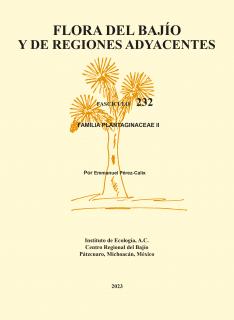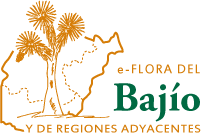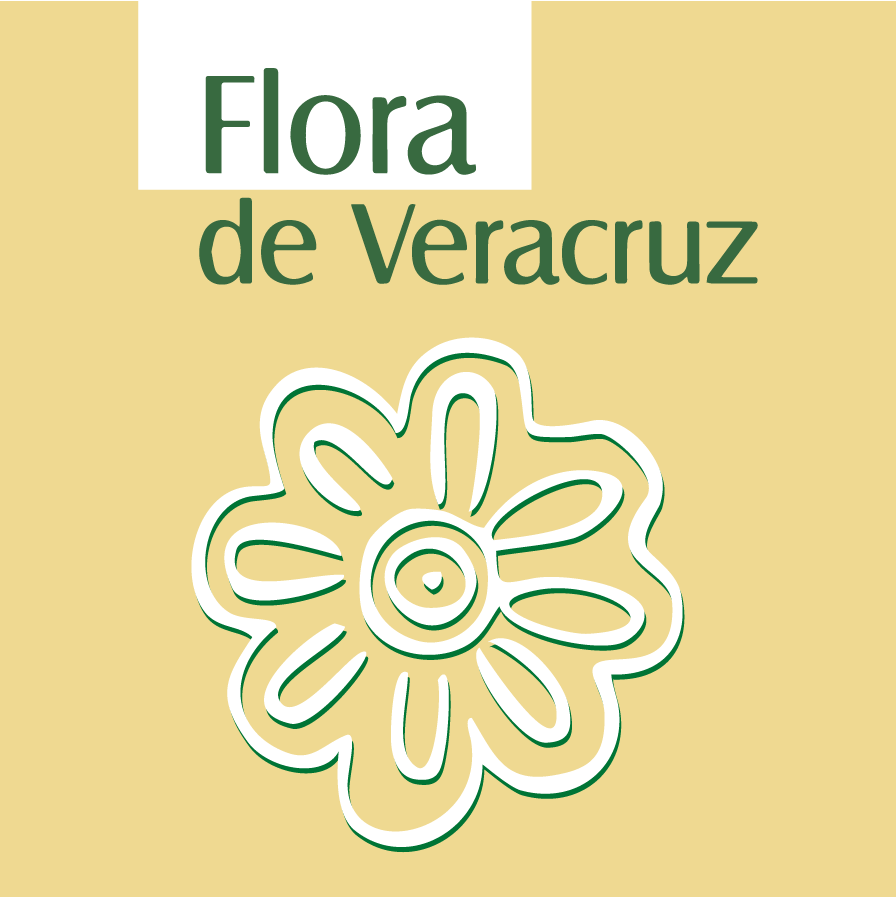FAMILIA PLANTAGINACEAE II
Palabras clave:
Penstemon, Veronica, mirto, Flora, BajíoSinopsis
Actualmente Plantaginaceae incluye diversas tribus, o parte de estas, anteriormente clasificadas en las tradicionales Scrophulariaceae; además, otras familias, como Callitrichaceae, Hippuridaceae y parte de Globulariaceae, que se han reorganizado como consecuencia de los estudios de sistemática molecular realizados en el orden Lamiales (Olmstead & Reeves, 1995; Olmstead et al. 2001, Oxelman et al., 2005), que han aportado interpretaciones diferentes acerca de la delimitación de las familias del orden; así, en el de Olmstead et al. (2001) se reconoció a un grupo que incluye a Plantaginaceae en sentido estricto junto con los taxa mencionados anteriormente, al cual denominaron el clado Veronicaceae, cuyo nombre aceptado a rango de familia corresponde a Plantaginaceae, que es el nombre conservado más antiguo. A partir de estos estudios este concepto de la familia es el que se ha considerado desde entonces (i.e. APG II, 2003; Stevens, 2001 onwards).
Los géneros de Plantaginaceae que se registran en el territorio de la Flora del Bajío y Regiones Adyacentes, son: Bacopa Aubl., Callitriche L., Cymbalaria Hill, Gratiola L., Lophospermum D. Don, Maurandella (A. Gray) Rothm., Maurandya Ortega, Mecardonia Ruiz & Pav., Nuttallanthus D. A. Sutton, Penstemon Schmidel, RusseliaJacq., Scoparia L., Sibthorpia L., Stemodia L. y Veronica L.; además de Plantago L., previamente publicada en esta Flora (Ocampo, 2003).
Constituida por ca. 90 géneros, con aproximadamente 2000 especies; para México se reconocen 29 géneros que incluyen ca. 230 especies; en el área de estudio se registran 16 géneros, 47 especies, incluyendo las correspondientes a Plantago, 1 subespecie y 5 variedades.
Familia cosmopolita, diversa principalmente en las zonas templadas.
Citas
Plantaginaceae
Ocampo, A. G. 2003. Familia Plantaginaceae. Flora del Bajío y de Regiones Adyacentes 120: 1-21. DOI: https://doi.org/10.21829/fb.190.2003.120
Olmstead, R. G. & P. A. Reeves. 1995. Evidence for the polyphylly of the Scrophulariaceae based on chloroplast rbcl and ndhF sequences. Annals of the Missouri Botanical Garden 82: 176-193. DOI: https://doi.org/10.2307/2399876
Olmstead, R. G., C. W. de Pamphilis, A. D. Wolfe, N. D. Young & P. A. Reeves. 2001. Desintegration of the Scrophulariaceae. American Journal of Botany 88(2): 348-361.
Oxelman, B., P. Kornhall, R. G. Olmstead & B. Bremer. 2005. Further desintegration of the Scrophulariaceae. Taxon 54(2): 411-425. DOI: https://doi.org/10.2307/25065369
Stevens, P. F. 2001 onwards. Angiosperm Phylogeny Website. Version 14, July 2017 http://www.mobot.org/MOBOT/research/APweb/ (acceso mayo 2022).
Sutton, D. A. 1988. A revision of the tribe Antirrhineae. British Museum & Oxford University Press. London & Oxford. 575 pp.
Tank, D. C., P. M. Bearsley, S. A. Kelchner & R. G. Olmstead. 2006. Review of the systematics of Scrophulariaceae s. l. and their current disposition. Australian Systematic Botany 19: 289-307. DOI: https://doi.org/10.1071/SB05009
The Angiosperm Phylogeny Group. 2003. An update of the Angiosperm Phylogeny Group classification for the orders and families of flowering plants: APG II. Botanical Journal of the Linnean Society 141: 399-436. DOI: https://doi.org/10.1046/j.1095-8339.2003.t01-1-00158
Bacopa
Cramer, L. H. 1981. Scrophulariaceae. 3: 421. In: Dassanayake M. D. & F. R. Fosberg (eds.) Revised Handbook to the Flora of Ceylon. Amerind Publishing Co. Pvt. Ltd., New Delhi.
Callitriche
Fassett, N. C. 1951. Callitriche in the New World. Rhodora 53: 137-155; 161-182; 185-194; 209-222.
González, M. C. A. 2017. Callitrichaeae, In: Lot, A. (ed.). Plantas acuáticas mexicanas, una contribución a la Flora de México. Volumen II, Parte 1. Universidad Nacional Autónoma de México, Instituto de Biología, Ciudad de México. pp. 47-51.
Cymbalaria
Pennell, F. W. 1935. Cymbalaria. In: The Scrophulariaceae of eastern temperae North America. In: Monographs, Academy of natural sciences of Philadelphia pp. 316.
Lophospermun, Maurandella, Maurandya y Nuttallanthus
Elisens, W. J. 1985. Monograph of the Maurandyinae (Scrophulariaceae-Antirrhineae). Systematic Botany Monographs 5: 66-85.
Penell, F. W. 1919. Scrophulariaceae of the local flora II. Torreya 19(8): 143-152.
Sutton, D. A. 1988. A revision of the tribe Antirrhineae. British Museum & Oxford University Press. London & Oxford. 575 pp.
Penstemon
Crosswhite, F. S. 1967. Revision of Penstemon section Habroanthus (Scrophulariacea) I: conspectus. The American Midland Naturalist 77(1): 1-11. DOI: https://doi.org/10.2307/2423421
Crosswhite, F. S. 1970a. Penstemon coriaceus the correct name of Penstemon schaffneri (Scrophulariaceae). The Southwestern Naturalist 15(1): 142.
Crosswhite, F. S. 1970b. Revision of Penstemon (section Leptosptemon) serie Racemosi. The American Midland Naturalist 84(1): 237-243. DOI: https://doi.org/10.2307/2423740
Straw, R. M. 1959. Los Penstemon de Mexico. I. Sobre la confusión entre Penstemon lanceolatus y Penstemon imberbis. Boletín de la Sociedad Botánica de México 24: 39-52. DOI: https://doi.org/10.17129/botsci.1060
Straw, R. M. 1962. The Penstemon of Mexico. II. Penstemon hartwegii, Penstemon gentianoides, and their allies. Boletín de la Sociedad Botánica de México 27: 1-25. DOI: https://doi.org/10.17129/botsci.1073
Straw, R. M. 1963. The Penstemon of Mexico. III. Two subsections in the section Fasciculus. Brittonia 15: 49-64. DOI: https://doi.org/10.2307/2805040
Straw, R. M. 1966. A redefinition of Penstemon (Scrophulariaceae). Brittonia 18(1): 80-95. DOI: https://doi.org/10.2307/2805112
Straw, R. M. 1984. Penstemon miniatus (Scrophulariaceae): New combinations. Brittonia 36(1): 67. DOI: https://doi.org/10.2307/2806295
Russelia
Argüelles, E., R. Fernández y S. Zamudio. 1991. Listado florístico preliminar del Estado de Querétaro. Flora del Bajío y de Regiones Adyacentes, Fascículo Complementario II: 1-155. DOI: https://doi.org/10.21829/fb.144.1991.II
Carlson, M. C. 1957. Monograph of the genus Russelia (Scrophulariaceae). Fieldiana Botany 29(14): 231-292. DOI: https://doi.org/10.5962/bhl.title.2398
Pérez-Calix, E. 2020. Una especie nueva de Russelia (Plantaginaceae) originaria de Guanajuato y Querétaro, México. Revista Mexicana de Biodiversidad 91: e913042. DOI: https://doi.org/10.22201/ib.20078706e.2020.91.3042
Standley, P. C. 1924. Russelia. In: Trees and shrubs of Mexico. Contributions from the United States National Herbarium 23(4): 1308-1311.
Scoparia
Barringer, K. & W. Burger. 2000. Scrophulariaceae. Flora Costaricensis, Fieldiana Botany 41: 1-69.
Chodat, R. 1908. Etude critique des genres Scoparia L. et Hasslerella Chod. Bulletin de L´Herbier. Boissier, sér. 2, 8: 1-16.
Fries, R. E. 1906. Systematische Übersicht der Gattung Scoparia. Arkiv för Botanik 6: 1-31.
Standley, P. C. & L. O. Williams. 1976. Scrophulariaceae. Flora of Guatemala. Fieldiana Botany 24(9): 1-603.
Stemodia
Turner, B. L. & C. C. Cowan. 1993. Taxonomic overview of Stemodia (Scrophulariaceae) for North America and the West Indies. Phytologia 74(2): 61-103.
Veronica
Martínez-Ortega, M. M. & E. Rico. 2001. Taxonomy of Veronica subsect. Serpyllifoliae (Scrophulariaceae). Botanical Journal of the Linnean Society 135(2): 179-194. DOI: https://doi.org/10.1111/j.1095-8339.2001.tb01090.x
Penell, F. W. 1921. Veronica in North and South America. Rhodora 23(265): 1-22, 29-41.
Pérez-Calix, E. 1996. Flora y vegetación de la Cuenca del Lago de Zirahuén, Michoacán, México. Flora del Bajío y de Regiones Adyacentes, Fascículo Complementario XIII: 1-73. DOI: https://doi.org/10.21829/fb.155.1996.XIII
Sánchez Agudo, J. Á., M. M. Martínez-Ortega, S. Cafferty & E. Rico. 2012. A contribution toward clarifying the nomenclature of Veronica L. (Plantaginaceae). Taxon 61(4): 867-870. DOI: https://doi.org/10.1002/tax.614013

Publicado
Colección
ISSN en línea
Licencia

Esta obra está bajo una licencia internacional Creative Commons Atribución-NoComercial 4.0.






